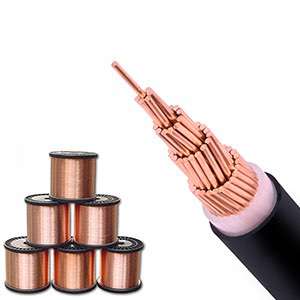 Author: Joey Wan
Author: Joey Wan  July 29,2022
July 29,2022
Power cables are cables used to transmit and distribute electrical energy. Power cables are often used in urban underground power grids, power station lead-out lines, internal power supply in industrial and mining enterprises, and underwater transmission lines across rivers and seas.
In power lines, the proportion of cables is gradually increasing. Power cable is a cable product used to transmit and distribute high-power electrical energy in the main line of the power system, including 1-500KV and above various voltage levels and various insulation power cables.


The use of power cables has a history of more than 100 years. In 1879, American inventor T.A. Edison wrapped jute around a copper rod and threaded it into an iron pipe, and then filled it with an asphalt mixture to make a cable. He laid this cable in New York and pioneered underground power transmission. The following year, the Englishman Callender invented the asphalt-impregnated paper insulated power cable. In 1889, the British S.Z. Ferranti laid a 10 kV oil-impregnated paper insulated cable between London and Detford. In 1908, the UK built a 20 kV cable network. Power cables are being used more and more widely. In 1911, Germany laid a 60 kV high-voltage cable, which started the development of high-voltage cables. In 1913, the German M. Horchstedt developed a component-phase shielded cable, which improved the electric field distribution inside the cable and eliminated the tangential stress on the insulating surface, which became a milestone in the development of power cables. In 1952, Sweden laid 380 kV EHV cables in the northern power plant, realizing the application of EHV cables. By the 1980s, UHV power cables of 1100 kV and 1200 kV had been made.
Voltage class
According to the voltage level, it can be divided into medium and low voltage power cables (35 kV and below), high voltage cables (above 110 kV), ultra-high voltage cables (275-800 kV) and UHV cables (1000 kV and above). In addition, it can also be divided into AC cables and DC cables according to the current system.
Insulating material
1. Oil-impregnated paper insulated power cable is a power cable with oil-impregnated paper as insulation. Its application history is the longest. It is safe and reliable, has a long service life and is inexpensive. The main disadvantage is that the laying is limited by the drop. Since the development of non-drip paper-impregnated insulation, the problem of drop limit has been solved, allowing oil-impregnated paper-insulated cables to continue to be widely used.
2. Plastic insulated power cables Power cables whose insulation layer is extruded plastic. Commonly used plastics are polyvinyl chloride, polyethylene, and cross-linked polyethylene. The plastic cable has the advantages of simple structure, convenient manufacturing and processing, light weight, convenient laying and installation, and is not limited by the laying drop. Therefore, it is widely used as medium and low voltage cables, and has a tendency to replace sticky impregnated oil-paper cables. Its biggest disadvantage is the presence of dendritic breakdown, which limits its use at higher voltages.
3. Rubber insulated power cable.The insulating layer is made of rubber plus various compounding agents. After fully mixing, it is extruded and wrapped on the conductive wire core, and is formed by heating and vulcanization. It is soft and elastic, suitable for frequent movement and small bending radius.
The rubber materials commonly used for insulation include natural rubber-styrene-butadiene rubber mixture, ethylene propylene rubber, butyl rubber, etc.
